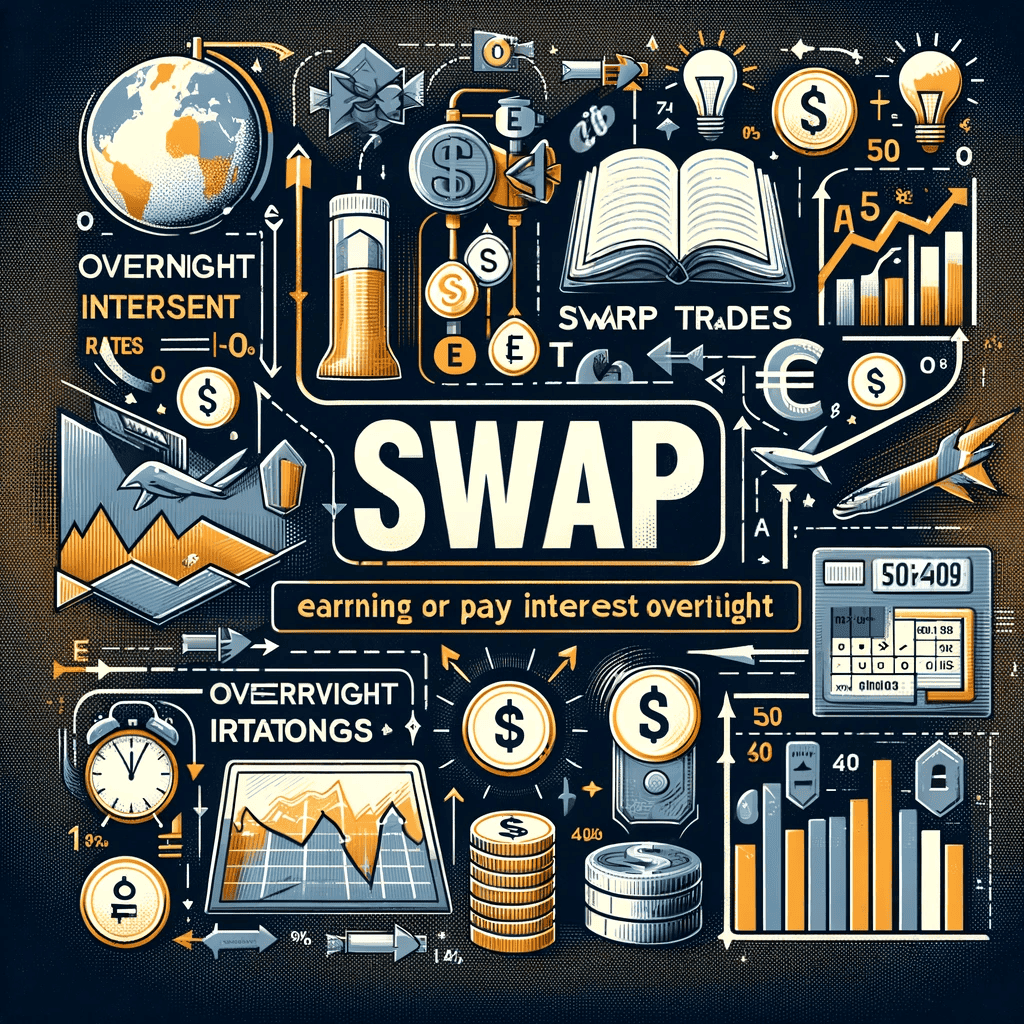
Introduction
Swap trading in Forex is a strategy that involves maintaining positions overnight, impacting trading dynamics through swap rates. This introduction offers an overview of swap trading, delves into the significance of swap rates on trading positions, and differentiates between scenarios of paying or receiving swaps.
– Overview of Swap Trading: In Forex, swap trading refers to the process where a trader earns or pays interest on positions held overnight. This strategy is deeply intertwined with the dynamics of overnight interest rates in the currency market.
– Significance of Swap Rates: Swap rates represent the interest rate differential between two currencies in a Forex pair. These rates can significantly affect the net profit or loss of a trade, depending on whether a trader is in a long (buy) or short (sell) position.
– Paying vs. Receiving Swap Scenarios: Depending on the direction of the trade and the interest rate differential, traders may either pay swap fees (when the interest cost of the currency bought is higher than that of the sold currency) or receive swap payments (when the interest cost of the currency bought is lower).
The next section, “Delving into the Mechanics of Swap Trading,” will explore the concept of swap rates, how they are calculated, and the factors influencing these rates.
Delving into the Mechanics of Swap Trading
Understanding the Concept of Swap Rates
Swap rates play a crucial role in Forex trading, especially when positions are held overnight. This segment will explain the concept of swap rates and their significance in swap trading.
– Swap Rates Explained: Swap rates in Forex are essentially the interest rate differentials between the two currencies of a trading pair. These rates determine the cost or gain incurred by holding a position overnight.
– Long and Short Swap Rates: The long swap rate applies when a trader holds a long position and the short swap rate is applicable for a short position. These rates vary based on whether you’re buying or selling the currency pair and the respective interest rates of the currencies involved.
Calculating Swap Rates
Understanding the calculation of swap rates is key to effective swap trading.
– Swap Rate Formula: The swap rate is calculated based on the nominal value of the position, the interest rate differential between the two currencies, and the number of days the position is held.
– Example Calculation: For instance, if a trader holds a long position in EUR/USD, the swap rate would be determined based on the difference between the interest rates of the Euro and the U.S. Dollar, multiplied by the position size and adjusted for the number of days the position is open.
Factors Influencing Swap Rates
Several external factors can influence the swap rates in the Forex market.
– Central Bank Interest Rates: Central bank policies and interest rate decisions are primary drivers of swap rates. Changes in these rates can significantly alter the swap rate differentials between currencies.
– Market Liquidity and Currency Strength: The liquidity of the currency pair and the relative strength of the currencies also play a role in determining the swap rates.
The next section, “Implications of Swap Trading on Forex Positions,” will delve into how swap rates can impact the overall profitability of trades, analyze long and short swap scenarios, and discuss managing swap costs and utilizing swap strategies.
Implications of Swap Trading on Forex Positions
Impact of Swap Rates on Profitability
Swap rates can significantly influence the overall profitability of a trading position in Forex, depending on whether they add to or reduce the gains or losses.
– Effect on Trading Profitability: When swap rates are favourable, they can add to the profits of a position held overnight. Conversely, unfavourable swap rates can increase the losses or reduce the profits of a trade.
– Influencing Trading Decisions: Understanding how swap rates work is crucial, as they can influence decisions on whether to hold a position overnight, especially in trades where the profit margin is tight.
Long Swap and Short Swap Scenarios
Both long and short swap scenarios have different impacts on trading positions and require distinct considerations.
– Long Swap Rates on Long Positions: Holding a long position in a currency pair with a positive long swap rate can result in additional earnings from the trade. However, a negative long swap rate will incur a cost.
– Short Swap Rates on Short Positions: Similarly, holding a short position with a positive short swap rate can be beneficial, whereas a negative short swap rate means paying extra costs.
Managing Swap Costs and Utilizing Swap Strategies
Incorporating swap costs into trading plans and risk management strategies is essential for successful swap trading.
– Swap Costs in Trading Plans: Traders should factor in swap costs when planning their trades, considering them alongside other transaction costs and potential profits.
– Carry Trades and Swap Strategies: One popular swap trading strategy is the carry trade, where traders seek to profit from the interest rate differentials between currencies. This involves buying a currency with a higher interest rate and selling a currency with a lower rate, potentially earning positive swap payments.
The final section, “Considerations and Limitations of Swap Trading,” will explore the risks associated with overnight price movements, the importance of accounting for swap fees and transaction costs, and the need to monitor interest rate dynamics and market conditions continuously.
Considerations and Limitations of Swap Trading
Acknowledging Overnight Risks
One of the critical aspects of swap trading is the risk associated with holding positions overnight, which can significantly affect swap calculations and trading outcomes.
– Market Volatility: Overnight price movements can be unpredictable, potentially leading to substantial changes in the value of open positions. This volatility needs to be factored into any swap trading strategy.
– Risk Management: Effective risk management, including appropriate position sizing and setting stop-loss orders, is crucial to safeguard against unexpected market movements that could occur outside of regular trading hours.
Accounting for Swap Fees and Transaction Costs
Incorporating swap fees and other transaction costs is vital when evaluating the potential profitability of swap trading strategies.
– Impact on Net Profits: Swap fees, along with other transaction costs like spreads and commissions, can eat into the profits of a trade. Traders need to calculate these costs accurately to ensure that the potential gains justify the expenses.
– Cost-Benefit Analysis: Performing a thorough cost-benefit analysis for each trade can help traders make more informed decisions, especially in strategies that rely heavily on favourable swap rates.
Monitoring Interest Rate Dynamics and Market Conditions
Staying informed about interest rate changes and broader market conditions is essential for successful swap trading.
– Interest Rate Fluctuations: Central bank policies and economic conditions can lead to fluctuations in interest rates, which directly impact swap rates. Traders must stay updated on these changes to adjust their strategies accordingly.
– Adapting to Market Dynamics: The Forex market is dynamic, and trading strategies, including those based on swap rates, need to be flexible enough to adapt to changing market conditions.
The final section, “Conclusion,” will provide a summary of the key principles of swap trading, its potential benefits and drawbacks, and practical advice for traders looking to engage in this type of trading.
